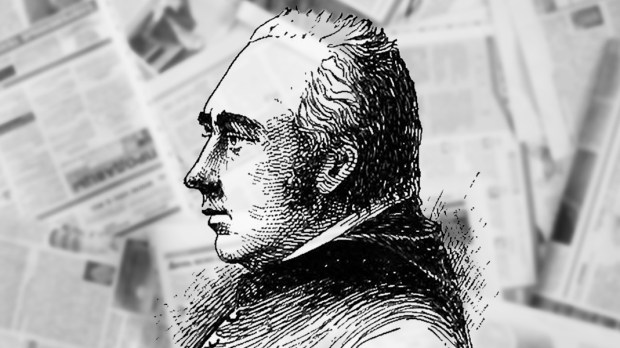The man who started the first Catholic newspaper in the United States had plenty of experience in his native Ireland to prepare him for the project. Bishop John England spent the early years of his priesthood teaching the faith, editing newspapers, and publishing catechetical materials. He was also a staunch defender of the rights of Catholics in British-dominated Ireland in the early 19th century.
Born in Cork in 1786, he was ordained a priest there in 1809. Just two days before his 34th birthday, he was consecrated a bishop and assigned to the Diocese of Charleston, South Carolina. His small American flock consisted of poor immigrants scattered across the states of South and North Carolina and Georgia. And they had a tough time being accepted in their new homeland. As he did in Ireland, Bishop England spoke out on behalf of the victims of anti-Catholic prejudice, but newspapers wouldn’t publish his letters to the editor. He actually had to buy advertising space to get them published.
England had the experience, and now the impetus, to found his own newspaper. And that’s how the United States Catholic Miscellany became the first Catholic newspaper in the United States.
Now called the Catholic Miscellany, it is the official newspaper of the Roman Catholic Diocese of Charleston. Pope Francis gave it a shoutout the other day when he addressed members of the Catholic Press Association for their annual Catholic Media Conference. Originally planned for Portland, Oregon, the meeting took place through the internet due to the continuing COVID-19 pandemic.
“The theme you have chosen for this year’s Conference — Together While Apart — eloquently expresses the sense of togetherness that emerged, paradoxically, from the experience of social distancing imposed by the pandemic,” the pope said. “In my Message for last year’s World Communications Day, I reflected on how communication enables us to be, as St. Paul says, ‘members of one another’ (cf. Eph 4:25), called to live in communion within an ever expanding network of relationships. Because of the pandemic, all of us have come to appreciate this truth more fully. Indeed, the experience of these past months has shown how essential is the mission of the communications media for bringing people together, shortening distances, providing necessary information, and opening minds and hearts to truth.
“It was precisely this realization that led to the establishment of the first Catholic newspapers in your country and the constant encouragement given them by the Church’s pastors,” Francis continued. “We see this in the case of the Charleston Catholic Miscellany, launched in 1822 by Bishop John England and followed by so many other newspapers and journals. Today, as much as ever, our communities … count on newspapers, radio, TV and social media to share, to communicate, to inform and to unite.”
When Bishop England announced his new publishing venture, he proclaimed: “Amongst the various wants of the Catholics of these states I do not know of a greater temporal (one) than a weekly paper, the principal scope of which will be fair and simple statements of Catholic doctrine from authentic documents, plain and inoffensively exhibited, refutation of calumnies, examination and illustration of misrepresented facts of history, biographies of eminent ecclesiastics and others connected with the Church, reviews of books for and against Catholicity, events connected with religion in all parts of the world, etc.”
While England, who died in Charleston in 1842, was guided by a spirit of uniting immigrants with the larger community, his newspaper would in only a few years go through a great period of division. Bishop England’s successor, Bishop Ignatius A. Reynolds, continued publishing the Miscellany. The priest who served as editor, Fr. Patrick N. Lynch, himself became bishop in 1858. In the meantime, Georgia became a diocese of its own.
When South Carolina seceded from the Union in 1860, the Miscellany changed its name, dropping “United States.” An editor said that he could no longer tolerate what he called “those two obnoxious words, … which being henceforth without truth of meaning would ill become the title of the paper.”
But the Miscellany itself ceased publication after a devastating fire ruined its offices and printing press, as well as the Cathedral of Saint John and Saint Finbar, on December 11, 1861. The paper was dormant for 90 years for lack of funds, until the Catholic Banner appeared in 1951, published as a section of Our Sunday Visitor. In 1960, The Banner became part of a three-diocese consortium, designed and published in Waynesboro, Georgia, with some local articles and photographs accompanying national and international copy from Catholic News Service.
In 1990, Bishop David B. Thompson returned the diocesan newspaper to its historic roots, renaming it The New Catholic Miscellany and moving it to Charleston. In March 1995, The Miscellany staff began producing the paper in-house and printing it locally. That same year, the paper won its first national award for excellence. In 2002, the word New was dropped from the title and the paper became The Catholic Miscellany.
Today, the Catholic Press Association honors England’s memory through the annual Bishop John England Award for “publishers who used the Catholic press to defend the rights of religion and individuals in a free society,” according to the CPA website. This year’s recipient was Bishop Nicholas A. DiMarzio of Brooklyn, publisher of the Brooklyn Tablet.

